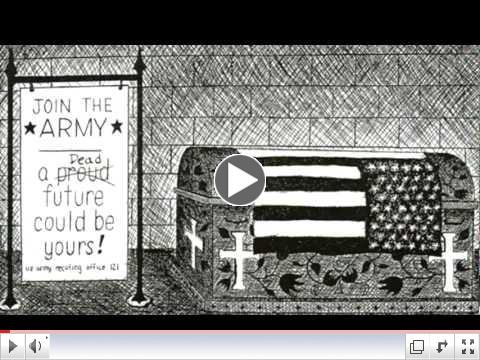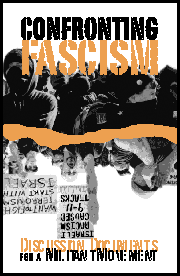Historians vs the War Conference  Historians vs. The War
National Conference 5-7 April 2013
Baltimore, Maryland
"The New Faces Of War", A Conference for Historians and Activists
|
CCDS Statement on Hugo Chavez 
The Committees of Correspondence for Democracy and Socialism shares in the grief of the people of Venezuela, Latin America and freedom loving people throughout the world in the loss of Venezuela's President Hugo Chavez...
|
Dialogue & Initiative 2012 The new annual edition of our journal of discussion and analysis is now out. More than 130 pages, it includes 13 articles related to the Occupy! movement, as well as seven others vital to study in this election year. Cost is $10 plus shipping. Or get one by becoming a sustainer. Click the title to buy it directly.
|
New Issue of Mobilizer

Check out what CCDS has been doing...
|
Blog of the Week:

Five Great Online Tools for Mining Public Records
|
Lost Writings of SDS..
Revolutionary Youth the the New Working Class: The Praxis Papers, the Port Authority Statement, the RYM Documents and other Lost Writings of SDS
Edited by Carl Davidson 
Changemaker, 273pp, $22.50
For the full contents, click the link and view 'Preview' under the cover graphic.
|
|
By Randy Shannon, CCDS

"Everyone has the right to work, to free of employment, to just and favorable conditions of work and to protection against unemployment."
- United Nations Universal Declaration of Human Rights, December 10, 1948
I. Introduction
The "Great Recession" that began in 2007 has caused the greatest percent of job losses since the Great Depression of 1929. This crisis is the end of an era of unrestrained 'neo-liberal' capitalism that became public policy during the Reagan administration. The crisis marks a new level of instability with the growth of a global financial elite that targeted US workers and our trade unions after World War II.
|
|
Order Our
Full Employment Booklets
 |
...In a new and updated 2nd Edition
Capitalism may well collapse under its own excesses, but what would one propose to replace it? Margaret Thatcher's mantra was TINA...There Is No Alternative. David Schweickart's vision of "Economic Democracy" proposes a serious alternative. Even more fundamentally, it opens the door to thinking about alternatives. His may or may not turn out to be the definitive "successor system," but he is a leader in breaking out of the box. |
|
Quick Links...
CCDS Discussion |
Sex and the Automobile in the Jazz Age

By Peter Ling in History Today: 'Brothels on wheels' thundered the moralists but Peter Ling argues the advent of mass motoring in the 1920s was only one of the changes in social and group relationships that made easier the pursuit of carnal desire.
|
 A Memoir of the 1960s by Paul KrehbielAutumn Leaf Press, $25.64 A Memoir of the 1960s by Paul KrehbielAutumn Leaf Press, $25.64 | | Shades of Justice Video: Bringing Down a President, Ending a War |
|
Carl Davidson's Latest Book:
New Paths to Socialism

Essays on Mondragon, Marx, Gramsci and the Green and Solidarity Economies |
Solidarity Economy:What It's All About

Edited by Jenna Allard, Carl Davidson and Julie Matthaei
Buy it here...
|

Voices from the Underground Press of the 1960s, Part 2- Foreword by Susan Brownmiller
- Preface by Ken Wachsberger
$37.50 + $6 shipping
|
|
Discussion Documents for a Militant Movement

By Don Hamerquist
|
|
|
|
An Invitation to CCDSers and Friends...
 Two Budgets, Two Futures with Obama in the Middle
We're the Committees of Correspondence for Democracy and Socialism...Do you have friends who should see this? Pass it on...Do you have a blog of your own? Others you love to read every day? Well, this is a place where you can share access to them with the rest of your comrades. Just pick your greatest hits for the week and send them to us at carld717@gmail.com!
Most of all, it's urgent that you defend voter rights, plan for 2014 races now, oppose austerity, support the Congressional Progressive Caucus' 'Back to Work Budget' and end the wars! We're doing more than ever, and have big plans. So pay your dues, make a donation and become a sustainer. Do it Now! Check the link at the bottom...
|

Keith Ellison (D-MN) co-chair of the Congressional Progressive Caucus, introducing new budget
Analysis of the Congressional Progressive Caucus budget for fiscal year 2014
By Andrew Fieldhouse and Rebecca Thiess
Economic Policy Institute
March 13, 2013 - The Congressional Progressive Caucus (CPC) has unveiled its fiscal year 2014 (FY2014) budget, titled Back to Work. It builds on recent CPC budget alternatives in prioritizing near-term job creation, financing public investments, strengthening the middle class, raising adequate revenue to meet budgetary needs while restoring fairness to the tax code, protecting social insurance programs, and ensuring fiscal sustainability.
Refer to the PDF of this paper for Figures A-E, visualizing The Back to Work budget's impacts on deficits, debt, and nondefense discretionary funding; Tables 1 and 2 detailing the policy changes within the budget; and summary tables 1 through 6 depicting budget totals as well as comparisons with current law and current policy baselines.
The Back to Work budget is focused on ending the ongoing jobs crisis, and it provides substantial upfront economic stimulus for that purpose. This paper details the budget baseline assumptions, policy changes, and budgetary modeling used in developing and scoring the Back to Work budget, and it analyzes the budget's cumulative fiscal and economic impacts, notably its near-term impacts on economic recovery and employment.1
We find that the Back to Work budget would have significant, positive impacts in the following areas:
Promoting job creation and economic recovery. The Back to Work budget would sharply accelerate economic and employment growth; it would boost gross domestic product (GDP) by 5.7 percent and employment by 6.9 million jobs at its peak level of effectiveness (within one year of implementation), while ensuring that fiscal support lasts long enough to avoid future fiscal cliffs that could throw recovery into reverse.2
Targeting a full-employment economy. The budget would rapidly restore the unemployment rate near to pre-recession levels of 5 percent. The unemployment rate would be expected to range between 5.0 and 5.6 percent by 2014, in line with what the Congressional Budget Office (CBO) regards as full employment.
Restoring full economic health. U.S. economic output is currently $985 billion (5.9 percent) below potential, and the economy is projected to remain 6 percent below potential in 2013 under current law. The budget would effectively use fiscal stimulus to restore actual GDP to potential GDP-the key barometer for restoring full employment in the economy.
Financing job creation and public investments. The budget finances roughly $700 billion in job creation and public investment measures in 2013 alone and $2.1 trillion over 2013-2015.3 This fiscal expansion is consistent with Economic Policy Institute estimates of the fiscal support needed to rapidly restore the economy to full health (Bivens, Fieldhouse, and Shierholz 2013).
Strengthening social insurance. The Back to Work budget strengthens the social safety net and proposes no benefit reductions to social insurance programs-in other words, it does not rely on simple cost-shifting to reduce the budgetary strain of health programs. Instead, it uses government purchasing power to lower health care costs (health care costs are the largest threat to long-term fiscal sustainability) and builds upon efficiency savings from the Affordable Care Act. The budget also expands and extends emergency unemployment benefits and increases funding for education, training, employment, and social services as well as income security programs in the discretionary budget.4
Making targeted spending cuts. The budget focuses on modern security needs by returning Defense Department spending to 2006 levels. It ends emergency overseas contingency operation spending in FY2015 and beyond, and cuts non-emergency Defense Department spending by $897 billion over 10 years.
Raising revenue progressively. The budget restores adequate revenue and pushes back against income inequality by adding higher marginal tax rates for millionaires and billionaires, equalizing the tax treatment of capital income and labor income, restoring a more progressive estate tax, eliminating inefficient corporate tax loopholes, and enacting a financial transactions tax, among other tax policies. ...(Click title for more)
|
|

This week, two budgets lay out two visions and two futures for America
By Robert Borosage
Huffington Post via Alternet
March 14, 2013 - Budgets are pure EGO -- eyes glaze over. But this week revealed two budgets -- Rep. Paul Ryan's Republican "Path to Prosperity" 2014 budget and the Congressional Progressive Caucus "Back to Work Budget" -- that in stark terms lay out two visions and two futures for America.
Next week the Congress will vote on each one of them. Neither will become law, but Ryan's budget is expected to pass with the support of virtually the entire Republican majority. The CPC budget will struggle to win a majority of the Democratic caucus. For those who take a look, the contrast will open your eyes.
Both parties agree that we suffer from mass unemployment, declining wages, and growing inequality. Both agree that rising future deficits should be addressed. But they offer completely different responses to these realities.
Ryan's Rerun
Ryan's budget is a retread of his previous offerings, the same ideas that were rejected by voters in the 2012 election. Like the old Bourbon kings, he has learned nothing and forgotten nothing. Once more he doubles down on the failed ideas of the past, and once more he brazenly seeks credit for making hard choices while refusing to tell us what those choices are. The cowardice and lack of candor reflect just how unpopular these ideas are.
The basic strategy is the same; the only new packaging is the pretense of balancing the budget in 10 years. Ryan does that by adopting the $600 billion in "fiscal cliff" taxes that Republicans voted against, the Medicare tax hikes that were part of the Obamacare that Ryan proposes to repeal, and, most brazenly, the infamous $716 billion in "Medicare cuts" that Ryan and Romney and legions of Republicans have railed against over the last two election cycles.
Ryan's basic strategy is unchanged. He would lower rates on income and corporate taxes. He does this despite studies showing that lowering rates over the last decades have produced more inequality, but not more growth. With the top 1 percent capturing a staggering 121 percent of the income growth coming out of the Great Recession, and corporate profits at record highs as a percentage of the economy, Ryan still argues that if they just had more money, they would start investing here at home.
The lower tax rates, Ryan claims, will be paid for by closing loopholes and eliminating "tax expenditures" -- only he reveals none of those that he would close. Studies show millionaires could give up all their tax deductions and still pocket a big tax break from the Ryan plan. By definition, middle class families will end up paying more -- and will face the loss of tax deductions for mortgages, for employer-based health care, for state and local taxes and more. No wonder Ryan doesn't want to reveal what's behind the curtain.
Ryan then calls for cutting $4.6 trillion in spending over 10 years from projected levels. $2.5 trillion of that comes from repealing Obamacare and gutting Medicaid. That will leave, according to estimates of the Urban League and the Congressional Budget Office, 40 to 50 million more poor and middle-income Americans uninsured, even as the wealthy and multinationals pocket their tax breaks. In addition, Ryan promises to dismember Medicare 10 years from now, turning it into a voucher that will push more and more costs on seniors over time.
Ryan would cancel the "sequestration cuts" for the military over the next decade while cutting even more from domestic services. All domestic services -- education, border patrol, workplace safety, food and drug monitoring, research and development, Head Start, infant nutrition, etc. -- would be cut to levels not seen in modern times. Naturally, Ryan does not identify what would be cut.
His budget calls for savaging spending in other mandatory programs -- targeting Pell Grants, food stamps, school lunches, the Earned Income Tax Credit, the Child Tax Credit, and supplementary support for the aged and the disabled poor. The bulk of his cuts will come from the most vulnerable among us.
The combination of tax cuts that add little to growth and deep spending cuts will be a jobs killer, with the Economic Policy Institute estimating the loss of about 2 million jobs in the first year of the Ryan plan. This would likely drive the economy back into a recession,
Republicans have voted for this budget plan in the past, and are expected to pass it again next week. It reflects who they are and what they believe in. Republicans are truly the champions of the 1 percent. They truly do believe that the rich bear too great a burden and the "47 percent" too little.
The CPC Back to Work Budget
Unlike Ryan's budget, the CPC Back to Work Budget did not receive a flood of mainstream media coverage. This is regrettable because it demonstrates that there is a dramatic alternative direction for America -- a program designed to rebuild the middle class and strengthen our ability to compete in the next century, even as we get deficits under control. And in stark contrast to the Ryan budget, the CPC budget is candid -- it lays out what it would tax and what it would cut, where it would invest and where it would save....(Click title for more)
|
|
By Bill Fletcher, Jr.
Logos, 2013, Vol 12, No. 1
There is a story that I often use to make a point regarding one of the central problems in organized labor in the USA. It goes like this:
A man jumped off of the Empire State Building in New York. As he was dropping past the 30th floor he was overheard saying "...so far, so good..."
For more than five decades organized labor in the USA has been in decline. At first the decline was not particularly noticeable since, through the early 1970s, organized labor still represented more than 25% of the non-agricultural workforce (down from 35% in 1955). Nevertheless the decline rapidly increased in the aftermath of the recessions of the 1970s and the advent of President Ronald Reagan and Reaganism (the homegrown variety of neo-liberal economics).
Having purged its left-wing in the late 1940s and abandoned any coherent sense of being a social movement on behalf of a class of people, organized labor drifted, slowly at first and then with increasing speed as gravity took hold. Despite evidence of decline, most of the leadership continued to insist that the situation was not 'that bad' and that either (1) their particular labor union would survive intact, and perhaps grow, or (2)the pendulum of U.S. politics would inevitably shift and unions would rise again.
Yet the rate of decline increased. In 1947 a Republican Congress passed the Taft-Hartley Act which amended the National Labor Relations Act. There were many regressive components to this statute but one in particular has performed like a slow-acting poison in the political system: so-called 'right to work'.
An incredible example of a misnomer, 'right to work' has nothing to do with offering a worker a right to a job, but instead is a weapon used to ensure that unions, which have a statutory obligation to represent all workers in a unionized facility regardless of union membership, have no right to insist upon dues from workers benefitting from such representation.
Thus, 'right to work' is really the 'right to be greedy.' It would be the equivalent of saying that citizens did not need to pay taxes to their city but would, regardless, receive access to the police, fire department, sanitation, for free! Reasonable?
Organized labor objected to 'right to work' [Section 14(b) in the Taft-Hartley Act] but never mounted a serious challenge to it. Initially 'right to work' was contained in the South and Southwest. A direct challenge to 'right to work' would have involved both a national legislative strategy and an active organizing campaign(s) in the South and the Southwest. Organized labor refused. After the failure of the Congress of Industrial Organization's "Operation Dixie" in the late 1940s, the bulk of organized labor abandoned any real thought to organizing the South and Southwest.
By not challenging 'right to work', organized labor was providing the conditions under which this poison could-and did-spread. In that sense, the recent 'right to work' victories, first in Indiana and most recently Michigan, should have come as no surprise. Tragic, yes; surprise, no.
Challenging 'right to work', however, would have involved more than lobbying and, indeed, more than a traditional organizing campaign. 'Right to work' was nothing short of a component of the declaration of war against workers represented by Taft-Hartley. As much as organized labor objected to Taft-Hartley, the dominant forces in the movement refused to accept the full implications of this assault.
To have moved against 'right to work' would have necessitated abandoning the anti-communism that fueled the purges of the Congress of Industrial Organizations. It would have also necessitated an approach to organizing in the South and Southwest that would have by necessity taken on the form of a mass social movement, akin to but more advanced than what took place in the 1930s and early 1940s. The reason for this is that to have conducted successful union organizing in the South and the Southwest would have involved taking on "race", and specifically organizing African Americans in the South and Chicanos/Mexican Americans in the Southwest; organizing these groups, not as an afterthought, but as core constituencies.
Evidence of the turn away from being a movement for social and economic justice for the working class was precisely found in this monumental failure. Yes, for years union orators would decry 'right to work', but at the end of the day they believed that it could be contained.
The spread of 'right to work' becomes an example of the extent of the crisis facing the unions, but it is not the sum total of the crisis. Yet, to address the continuing poison of 'right to work' there must be a transformation of the US labor movement on a scale that mirrors a reformation precisely because taking on 'right to work' is part of a larger challenge for labor. That challenge is summed up by the initial story: the ground is fast approaching.
Renewal?
Some years ago in a discussion with a very wealthy businessman, I was instructed on key steps in turning around a company that has collapsed or is near collapse. In thinking through his analysis, I realized that there are valuable lessons that are directly applicable to organized labor (and of course, there are some that are not at all applicable). Consider the following:
New leadership: It is very difficult to turn around any formation with the old leadership still in command. This does not necessarily imply a complete change, but it does mean that those who are in commanding heights must move on. One is reminded of the opening scenes from the film Patton with George C. Scott, where he takes command of US troops in North Africa after the disastrous battle at Kasserine Pass in Tunisia. The complete failure of the operation necessitated new leadership rather than tinkering around the edges.
Organized labor in the USA needs new leadership. Many of the new leaders are already within the ranks of unions andother social movements.
They are prepared to introduce new strategies and build new alliances. Most especially they recognize that the status quo is not only unacceptable but is, at best, temporary. They realize, in other words, that the ground is fast approaching.
Mission clarification and internal education: Organizations and movements can become lost. Their missions, developed in a different era, may have nothing relevant to say about the current moment and the near future.
Organized labor in the USA lost its mission in the late 1940s. Actually, it abandoned its mission and replaced it with a different one: the building of a labor lobby within the context of the mainstream USA. More than anything else organized labor refused to accept the inevitability of class struggle and instead insisted that the elimination of the left-wing in labor helped to ensure that a productive relationship could be built with capital. The elimination of the left-wing was not only the elimination of people and organizations, but it was also represented by unconditional support for US foreign policy and the repudiation of any sense that organized labor had a direct responsibility to un-organized labor, i.e., to the rest of the working class.
Turning this situation around necessitates a reassertion of a mission focused on social and economic justice founded upon a cold appraisal of the realities of class struggle in 21st century USA, and for that matter the 21st century planet Earth. It is a mission that involves a level of global labor solidarity the likes of which most of us have not seen in our life-times. But it also involves the building of strategic alliances in the USA that aim towards winning power for working people....(Click title for more)
|

By John Upton
Grist.org
In 2012, wind energy became the fastest-growing source of new electricity generation in the U.S., providing 42 percent of new generation capacity, according to the American Wind Energy Association.
Wind power is becoming so cheap and so commonplace that it appears poised to help blow up the country's nuclear power sector, according to a recent Bloomberg article (which you really should read in full). Other highlights from the piece:
$25 billion was spent on wind energy in the U.S. in 2012. The $25 billion outlay increased nationwide wind generating capacity by 13,124 megawatts - up 28 percent from 2011. That spending spree was fueled in large part by a mad scramble to qualify for federal tax credits that were set to expire at the end of last year (but were ultimately renewed by Congress). Wind-generated electricity met about 3.4 percent of of American demand in 2012, a figure that's expected to reach 4.2 percent next year. $120 billion spent on wind turbines since 2003 has increased wind power supplies 1,000 percent and created as much new electricity generation as could be provided by 14 new nuclear power plants.
In addition to federal tax credits, state-level renewable energy requirements are helping to spur wind's growth, and the nuclear industry thinks that's unfair:
Wind power has two advantages. Green energy laws in many states require utilities to buy wind energy under long-term contracts as part of their clean-energy goals and take that power even when they don't need it. Wind farms also receive a federal tax credit of $22 for every megawatt-hour generated.
Thus, even when there is no demand for the power they produce, operators keep turbines spinning, sending their surplus to the grid because the tax credit assures them a profit. ...
Meanwhile, nuclear and coal plants must continue running even as this "negative pricing" dynamic forces them to pay grid operators to take the power they produce.
"It is becoming more pronounced as more wind is coming on," Christopher Crane, chief executive officer of Chicago-based Exelon Corp. (EXC), said in a phone interview.
If the push to "over-develop" subsidized wind continues, "there is a very high probability that existing safe, reliable nuclear plants will no longer be competitive and will have to be retired early," according to Crane.
But Exelon, the biggest nuclear-power producer in the country, gets plenty of government help itself. A 2011 report from the Union of Concerned Scientists found that the nuclear power industry wouldn't even be viable without government support: "more than 30 subsidies have supported every stage of the nuclear fuel cycle, from uranium mining to long-term waste storage."
And wind turbines don't generate toxic waste or nuclear meltdowns. John Upton is a science aficionado and green news junkie who tweets, posts articles to Facebook, and blogs about ecology. He welcomes reader questions, tips, and incoherent rants: johnupton@gmail.com.
|

According to rally coordinators, some 500,000 protesters filled the Lisbon boulevard leading to the Finance Ministry on March 2. Many chanting "It's time for the government to go!" and "Screw the Troika, we want our lives back", referring to the lenders from the European Commission, European Central Bank and International Monetary Fund.
By Dick Nichols
Green Left Weekly
March 12, 2013 -- Links International Journal of Socialist Renewal -- Whenever there's a protest in Portugal you are almost certain to hear the haunting song, "Grandola, Vila Morena" ("Grandola, sunburnt town"), with its line "who most rules within you, O city, is the people". On Saturday, March 2, at massive protests across Portugal, "Grandola, Vila Morena" was sung by more voices than ever before.
That day up to one and a half million Portuguese responded to the call "Screw the Troika, who most rules is the people!" by filling the squares of 40 cities and towns to demand the immediate resignation of the government, a right-wing coalition of the Social-Democratic Party (PSD) and Democratic and Social Centre-People's Party (CDS-PP), headed by prime minister Pedro Passos Coelho.
"Grandola, Vila Morena", which was broadcast early on April 25, 1974, as the signal to launch the "Revolution of the Carnations" is again becoming the freedom hymn of the biggest Portuguese protest movement since that time. This is the expanding movement against the austerity policies being imposed by the Troika-the European Central Bank, European Union (EU) and International Monetary Fund (IMF)-as condition for the country receiving a €78 billion bailout.
March 2, which coincided with the seventh Troika inspection of its Portuguese protectorate, was organised by the "Screw the Troika" coalition of more than 100 social and community groups. The coalition had previously called the first massive demonstration against Coelho's implementation of austerity-a million-strong Lisbon demonstration on September 15 last year.
September 15 showed the depth of popular anger against a specific government measure, a proposed increase in social security contributions that was later dropped-a success for the movement. March 2 was much more: a protest against the entire gamut of Troika austerity policies and one that had a precise demand-government resignation and fresh elections.
As the "people's censure motion", voted by the 800,000 in Lisbon's vast waterfront square Terreiro do Paço said: "This government does not represent us. This government is illegitimate. It was elected on the basis of promises it did not fulfill. It promised that it would not increases taxes, but has increased them to unbearable levels. It guaranteed that it would not rob pensions nor cut financial support to workers, but not a day passes when it doesn't rob more money from workers and retirees. It swore that it would not sack public servants nor increase unemployment, but every hour that passes there are more people without work...
"This people's censure motion is the cry of a people that wants to participate. It is the public affirmation of the growing desire of the people to take the leadership of the country into their own hands, overthrowing a corrupt power...let the people rule!"
On the day
Compared to September 15, March 2 was more organised, with greater participation and support from trade union and left political forces, including the Left Bloc (BE), the Portuguese Communist Party (PCP) and the General Confederation of Portuguese Workers (CGTP). The Socialist Party, which in government had invited the Troika into the country in the first place, had to express its "sympathy" with the movement.
The various sectors of the population most affected by government policy-education workers, health workers, retirees and pensioners, the LGBTI community, culture workers and the unemployed-took part in the protests in various-coloured "tides". This is a concept taken from the Spanish protest movements against public sector cuts, where categories of affected workers wear the same-coloured t-shirt on demonstrations.
March 2 also brought out new sections of the community, included people attending their first demonstration. Notable was the increased presence of retirees who face cuts to already miserable pensions as part of the IMF's latest proposal to cut Portugal's spending by €4 billion in 2013.
Another increased presence was that of the lower ranks of the armed forces, not wearing uniform but grouped behind the banners of the three armed forces associations.
Popular chants of the day (rhyming in Portuguese) included "With Passos at the helm, the country goes on sinking", "It's time for the government to exit", "Your sacrifices are in their wallets", "Passos, thief, you're not worth a cent" and "One more push and the government bites the dust".
The anger of the day was summed up by protestor Fabio Carvalho in an interview for Reuters: "The government has left the people on bread and water and flogged off state assets at bargain-basement prices so as to pay the debts run up by corrupt politicians to benefit the banks."
Hardening mood
Writing in the March 5 Expresso, political commentator Daniel Oliveira noted the hardening mood among the protesters, especially the older generation. "One of the things talked about most on Saturday was the children who emigrate, who are unemployed, who are desperate. And the lack of prospects for their grandchildren. In a society such as Portugal, where the family is a kind of complementary welfare state (or even the main one), the old gather the suffering of all generations under their roof. And they are, themselves, the most sacrificed."
"Some of the retirees who took to the streets on Saturday were participating in a demonstration for the first time in their lives ... and it is only now, at more than 60 years of age and after almost 40 years of democracy, that they feel propelled into the street."
The anger has been intensified by the growing realisation that the government and Troika's Thatcherite claim that "there is no alternative" is bunkum. In a February survey by Diário de Noticias on where interviewees thought the government could cut to save and restore spending on health, education and pensions, 36% nominated interested payments on the public debt, 33% military spending and 57% spending on private public partnerships.
On March 3, Left Bloc MP Jorge Costa made this assessment (full article below): "Saturday's massive demonstrations have changed the immediate future of social struggle in our country ... that large scale popular mobilisation is not an isolated phenomenon or an occasional cry of the soul. It is the expression of concrete social struggle, a permanent fact of the national situation, of a majority that is speaking out against the cuts that are crushing our society."...(Click title for more)
|
Feature Film on Sister Rosetta Tharpe, Godmother of Rock 'n Roll  Southern-born, Chicago-raised and New York-made. She could play the guitar like nobody else... nobody. Discover the life, music and influence of African-American gospel singer and guitar virtuoso Sister Rosetta Tharpe from writer, producer and director Mick Csaky. During the 1940s-60s, Tharpe introduced the spiritual passion of her gospel music into the secular world of rock 'n' roll, inspiring some of its greatest stars, including Chuck Berry, Elvis Presley, Jerry Lee Lewis, and Little Richard. The film features archival performances and new interviews with musicians, producers and friends, including Joe Boyd, tour manager of the 1964 American Folk, Blues and Gospel Caravan; Lottie Henry of The Rosettes; Gordon Stoker of The Jordanaires; Howard Caroll of gospel group The Dixie Hummingbirds, which toured frequently with Tharpe; Anthony Heilbut, gospel record producer and writer; life-long friend Roxie Moore; Ira Tucker, Jr., son of The Dixie Hummingbirds' Ira Tucker, Sr.; Tharpe biographer Gayle Wald; and others.
|
| Trudge Toward Freedom: A Review of 'After Capitalism' by Dada Maheshvarananda

"Where do we come from? What are we? Where are we going?" by Paul Gauguin (image: creative commons)
In just a few pages I felt the brotherly embrace of a comrade-in-arms, a soul-mate, and a companion; further along his fierce intelligence and original insights challenged me to make new connections; by the end I was inspired to re-imagine next steps in my own efforts at movement-making.
By Bill Ayers
Online University of the Left
Dada Maheshvarananda is a monk and a social activist, an engaged intellectual and a writer whose powerful new book, "After Capitalism: Economic Democracy in Action", provides a comprehensive critique of the economic system that grips the planet and suffocates our lives, names the contemporary political moment we're facing with astonishing clarity, and illustrates with concrete cases and specific examples the practical steps needed to build a radical movement toward joy and justice, peace and love, sanity and balance.
It's a broad and ambitious book to be sure. In just a few pages I felt the brotherly embrace of a comrade-in-arms, a soul-mate, and a companion; further along his fierce intelligence and original insights challenged me to make new connections; by the end I was inspired to re-imagine next steps in my own efforts at movement-making. This is an essential book created by a gentle warrior.
The questions that animate Dada Maheshvarananda's work are the same ones I saw recently scrawled across a sprawling panorama created by the tormented painter Paul Gauguin-in 1897, after months of illness and suicidal despair, Gauguin produced on a huge piece of jute sacking an image of unfathomable figures amid scenery that might have been the twisted groves of a tropical island or a marvelously wild Garden of Eden; worshippers and gods; cats, birds, a quiet goat; a great idol with a peaceful expression and uplifted hands; a central figure plucking fruit; a depiction of Eve not as a voluptuous innocent like some other women in Gauguin's work but as a shrunken hag with an intense eye.
Gauguin wrote the title of the work in bold on top of the image; translated into English it reads:
Where do we come from?
What are we?
Where are we going?
These are questions-horrifying for Gauguin, inspiring for Dada Maheshvarananda-that rumble in the background on every page of "After Capitalism."
How can we see ourselves and our problems/challenges/potentials holistically? How can we connect our personal and spiritual seeking with the practical search for a better world for all? How can we live with one foot in the mud and muck of the world as it is while the other foot stretches toward a world that could be but is not yet? How can we transform ourselves to be worthy of the profound social transformations we desire and need? And how can we build within ourselves the thoughtfulness, compassion, and courage to dive into the wreckage on a mission of repair?
We begin by opening our eyes: ...(Click title for more)
|
|
Become a CCDS member today!
 The
time is long past for 'Lone Rangers'. Being a socialist by your self is
no fun and doesn't help much. Join CCDS today--$36 regular, $48
household and $18 youth. The
time is long past for 'Lone Rangers'. Being a socialist by your self is
no fun and doesn't help much. Join CCDS today--$36 regular, $48
household and $18 youth.
Better yet, beome a sustainer at $20 per month,
and we'll send you a copy of Jack O'Dell's new book, 'Climbing Jacobs
Ladder,' drawing on the lessons of the movement in the South in the
1950s and 1960s.
Solidarity, Carl Davidson, CCDS |
|
|